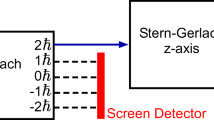Abstract
In this paper I aim to answer two questions: (1) Can spin be treated as a determinable? (2) Can a treatment of spin as a determinable be used to understand quantum indeterminacy? In response to the first question I show that the relations among spin number, spin components and spin values cannot be captured by a single determination relation; instead we need to look at spin number and spin value separately. In response to the second question I discuss three ways in which the determinables model might be modified to account for indeterminacy, and argue that none of them is fully successful in helping us to understand quantum indeterminacy.
Similar content being viewed by others
Notes
For a more detailed technical discussion of quantum indeterminacy on orthodox interpretations, see Bub (2000).
For arguments against intrinsic properties in quantum mechanics see Ladyman and Ross (2007), for a defense of intrinsic properties in fundamental physics see Ney (2010). Since the question of whether quantum properties are determinables is independent of the question whether they are intrinsic, I won’t be discussing these arguments in detail.
This last point seems a lot more controversial when we think of determinates as properties than when we think of them as predicates. How fine-grained our color predicates are would seem to be a matter of how finely human perception can draw distinctions between colors. By contrast, whether there are further differentiations of crimson, beyond what humans can distinguish, seems to be a matter of what’s true about color, not color terms. Since this won’t matter for the case of spin, though, I will set this worry aside.
Two caveats. First, the mere fact that a quantity can be mathematically represented by a vector does not entail that it is directed—position can be represented through vectors, but it is not directed [(for additional discussion see Beisbart (2009)]. Second, the distinction between sense and orientation seems to pertain primarily to dynamical quantities, like force, and less obviously to purely kinematic ones, like velocity. I do not have space here to pursue this question in more detail, but I don’t think it will make a difference for the discussion of spin.
Why not +1, –1, and +1/2 and –1/2? Because the sign in these cases represents the ‘sense’ of the vector, which I discuss separately.
Assuming, as I have been throughout the paper, that the probabilities cannot simply be understood as measures of our ignorance about the spin state of the particle. And of course we do have good reason to believe that as long as we follow the orthodox interpretation of the quantum state as fully represented by a ray in a suitable Hilbert space, probabilities cannot be understood as a measure of our ignorance. See Bub (2000) for discussion.
Wilson (2012) suggests that we should indeed do so, because determinables (and not just determinates) seem to play important roles in science, for example in laws of nature and in the special sciences. She also argues that standard objections to determinables as fundamental entities can be resisted by a friend of fundamental determinables.
References
Beisbart C (2009) How to fix directions or: are assignments of vector characteristics attributions of intrinsic properties? Dialectica 63:503–504
Bub J (2000) The challenge of quantum mechanics. Br J Philos Sci 51:597–615
Busse R (2009) Humean supervenience, vectorial fields, and the spinning sphere. Dialectica 63(4):449–489
Darby G (2010) Quantum mechanics and metaphysical indeterminacy. Aust J Philos 88(2):227–245
Dasgupta S (2013) Absolutism vs comparativism about quantity. Oxf Stud Metaphys 8:105–149
Dürr D, Goldstein S, Zanghì N (2013) Quantum physics without quantum philosophy. Springer, New York
Esfeld M (2014) Quantum humeanism, or: physicalism without properties. Philos Q 64(256):453–470
Funkhouser E (2006) The determinable-determinate relation. Noûs 40(3):548–569
Funkhouser E (2014) The logical structure of kinds. Oxford University Press, Oxford
Gillet C, Rives B (2005) The nonexistence of determinables: Or, a world of absolute determinates as default hypothesis. Noûs 39(3):483–504
Hawthorne J (2006) Quantity in Lewisian metaphysics. In: Metaphysical Essays, Clarendon, Oxford, p 229–237
Ladyman J, Ross D (2007) Every thing must go. Oxford University Press, Oxford
Massin O (2009) The metaphysics of forces. Dialectica 63(4):555–589
Ney A (2010) Are there fundamental intrinsic properties? In: Hazlett A (ed) New Waves in metaphysics, 11th edn. Palgrave Macmillan, London, pp 219–239
Williams JRG, Barnes E (2011) A theory of metaphysical indeterminacy. Oxf Stud Metaphys 6:103–148
Wilson JM (2012) Fundamental determinables. Philos Imprint 12(4):1–17
Wilson JM (2013) A determinable-based account of metaphysical indeterminacy. Inquiry 56(4):359–385
Author information
Authors and Affiliations
Corresponding author
Rights and permissions
About this article
Cite this article
Wolff, J. Spin as a Determinable. Topoi 34, 379–386 (2015). https://doi.org/10.1007/s11245-015-9319-2
Published:
Issue Date:
DOI: https://doi.org/10.1007/s11245-015-9319-2




